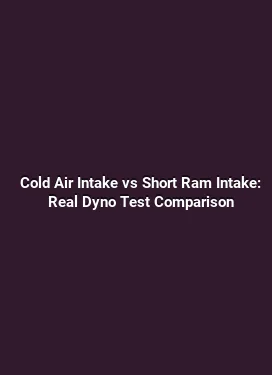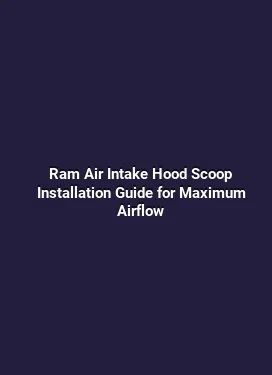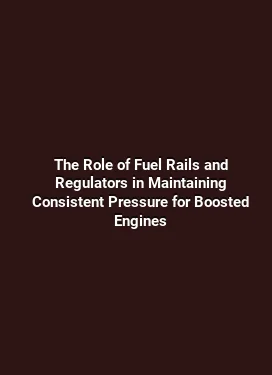Best Fuel Rail Upgrade Kits for High Pressure Applications
Understanding the Role of Fuel Rails in High Pressure Systems

In modern performance and tunable engines, fuel rails act as the central conduit delivering pressurized fuel from the pump to multi-point injectors. The transition to high pressure regimes, especially in direct injection and boosted setups, places greater demands on rail volume, mounting rigidity, and the ability to maintain consistent fuel temperatures. A well-chosen upgrade kit can reduce fuel pressure oscillations, improve injector response, and support reliable operation under demanding loads. When evaluating options, consider the rail’s material composition, port geometry, compatibility with high-flow injectors, and how the kit integrates with the existing fuel system: lines, regulators, and return paths. Superior kits emphasize predictable fuel distribution across all cylinders, which translates into smoother idle, more precise fueling, and improved throttle response at the upper ranges of RPM.
High pressure scenarios often require attention to returnless or return-type architectures, as well as the potential for heat soak during prolonged high-load operation. Upgraded rails typically incorporate larger internal volumes and reinforced mounting bosses to resist deformation and reduce pressure drop across the rail. This is particularly important in engines that operate with sustained boosts or aggressive cam profiles, where injector duty cycles rise and the risk of fuel pressure drop increases. The goal is to deliver consistent pressure to each injector while minimizing temperature rise that could affect fuel density and timing, especially in performance applications where fuel temperature management becomes a factor in overall efficiency.
Key Criteria for Selecting a High-Pressure Fuel Rail Upgrade
Choosing the right upgrade involves a balance of mechanical compatibility, flow characteristics, and durability under stress. The most critical criteria include integration compatibility with existing lines and fittings, the internal cross-section that governs fuel velocity, and the mounting system that ensures steady alignment with injector bays. Rails designed for high pressure should feature robust end caps, precision-machined bore finishes, and corrosion-resistant surface treatments to resist ethanol blends and higher sulfur content found in some races or tuning fuels. Additionally, look for rails that provide flexible mounting solutions to accommodate a range of injector spacings and shareable gaskets that minimize leaks at high pressures.
From a performance perspective, rail volume correlates with fuel delivery stability during rapid throttle transitions. A larger internal volume helps dampen pressure spikes associated with injector opening and closing, particularly in sequential injection configurations. However, excessive volume can increase fuel slip and slow responsiveness in extreme RPMs. The best upgrade kits strike a balance: enough capacity to stabilize pressure during peak demand without introducing significant response lag during shifting or quick throttle changes. Design elements such as vented end caps or integrated check valves can further enhance pressure consistency and reduce vapor lock risk in cold-start conditions.
Materials, Finish, and Durability Under High Pressure

Material choice drives weight, heat transfer, and corrosion resistance. Aluminum alloys with high thermal conductivity and build quality for automotive use are common, sometimes paired with anodized finishes to resist fuel and ethanol exposure. A smoothly machined interior surface minimizes turbulence and reduces the chance of fuel foaming, a factor that can affect injector performance. Durability under high pressure also depends on the end fittings’ compatibility with common fuel hoses and quick-connect systems. Quality kits provide secure clamping interfaces, robust O-ring seals, and machined pockets that align with standard injector layouts. The result is a system that maintains integrity under high boost and elevated temperatures, with reduced likelihood of micro-leaks during sustained operation.
Common Configurations and How They Influence Upgrade Decisions
Fuel rail upgrades come in several practical configurations. A popular option is a direct replacement rail that bolts onto existing mounting points while preserving factory fuel lines and regulators. This approach minimizes the need for extensive fuel system rewiring and is ideal for enthusiasts who want a straightforward upgrade with predictable results. Another approach uses a modular rail with adjustable injectors and a larger bore, enabling higher flow while maintaining compatibility with multiple injector brands. For turbocharged or supercharged engines, rails with integrated mounting features for heat shields and proximity to intake plenums can help manage heat transfer more effectively, preserving fuel density and injector responsiveness during prolonged high-load conditions. Some kits also include upgraded hardware such as high-flow regulators, compatible fuel lines, and compatible gaskets to ensure a cohesive upgrade experience.
In addition to the rail itself, effective upgrades consider the surrounding components. High-pressure systems benefit from harmonized pressure regulators, return-line sizing that prevents bottle-necking, and careful routing to minimize fuel-heater effects. When upgrading, verify the compatibility of connectors, sensor locations, and any fuel temperature or pressure sensing points that interface with engine management. Although many modern engines share common injector styles, the fitment details vary by platform, so cross-checking the exact model year, engine code, and fuel delivery layout is essential for a reliable installation.
Installation Tips: Preparing the Engine Bay for a Rail Upgrade
Before removing any hardware, disconnect the negative battery terminal and depressurize the fuel system in a controlled manner to avoid spills or leaks. A clean workspace and correct torque specifications for rail mounting bolts are essential to prevent warped mounting surfaces. During installation, take note of injector alignment and ensure O-rings are undamaged and properly lubricated with a compatible lubricant to avoid pinching. When connecting new lines, use the correct fittings and steadily tighten to the manufacturer’s recommended torque. Inspect the rail ends for any signs of cross-threading or misalignment that could lead to leaks. After installation, perform a careful fuel pressure test using the engine’s service manual procedures, watching for steady pressure propagation and the absence of pressure decay when the system is exercised at high load and during rapid throttle inputs.
Performance Implications: Real-World Gains and How to Measure Them
Upgrading to a high-pressure fuel rail typically yields measurable improvements in fuel delivery stability, especially under aggressive tunes. Users often report smoother throttle response, reduced injector noise, and more consistent fueling during track sessions or dyno runs. For engines operating with direct injection or hybrid systems, the rail’s ability to sustain uniform pressure across all injectors becomes a key factor in achieving repeatable horsepower gains. Performance verification can involve dynamometer testing, logging fuel pressure curves across RPM bands, and monitoring injector duty cycles. When tracking changes, compare baseline data with post-upgrade measurements to isolate the rail’s contribution from other variables in the fuel path, such as pump performance or line routing. Additionally, consider the impact on cold-start behavior and vapor management, as more stable rail pressure helps the engine achieve a reliable idle after startup even in fluctuating ambient conditions.
From a maintenance perspective, high-pressure rails require periodic inspection for O-ring wear, fastener integrity, and evidence of external leaks around end caps. Fuel quality, ethanol content, and exposure to high temperatures can accelerate O-ring degradation, so adopting a routine inspection schedule is prudent. For vehicles used in extreme driving conditions, some owners opt for rails with enhanced temperature resistance and corrosion protection as a long-term investment in reliability and consistent performance.
Understanding Compatibility: Matching Upgrades to Your Engine Platform
Compatibility is not simply a matter of bolt-on fit. It includes injector type compatibility (top-feed vs side-feed), rail bore size, and the spacing pattern that aligns with the engine’s cylinder head design. Some platforms use non-uniform injector spacings that necessitate rails tailored to each bank or cylinder arrangement. Additionally, consider the fuel rail’s integration with engine management sensors and the potential need for adapter fittings if switching injector brands or changing line diameters. Manufacturers typically publish a compatibility matrix or fitment guide; consulting this resource ensures that the chosen upgrade aligns with your engine code, injector model, and fuel pump characteristics. This forward planning reduces the risk of incompatible fittings, flow limitations, or misalignment that could compromise performance or safety.
Maintaining a Balanced Fuel System: Supporting Upgrades with Ancillary Upgrades
To maximize the benefits of a fuel rail upgrade, it is advisable to evaluate the surrounding components in the fuel delivery chain. Upgrading the fuel pump to a unit capable of sustaining higher pressures with ample headroom reduces the risk of starvation during peak-demand scenarios. In some builds, upgrading the fuel filter to a higher-flow, lower-porosity variant helps preserve consistent delivery and minimize contaminants that could affect injector performance. The interplay between the rail, regulator (if present), lines, and return paths determines the overall system’s resilience under high-load operation. A comprehensive approach often includes verifying line routing to minimize heat absorption from the exhaust or hot components, thus preserving fuel density and optimizing combustion stability in high-performance applications.
Maintenance Practices to Extend Rail Life and Performance
Routine inspection and preventive maintenance are essential. Periodically inspect O-rings, seals, and mounting hardware for signs of cracking, swelling, or leakage. If fuel smells are detected around the rail or fittings, re-seal or replace affected components promptly to prevent performance degradation or safety concerns. Keep a log of fuel quality characteristics, including octane rating, ethanol content, and any observed fluctuations in fuel pressure. This historical data helps in diagnosing anomalies and planning future upgrades that align with the engine’s performance goals. In environments with frequent track use or extreme temperatures, scheduling professional diagnostic checks can reveal subtle issues in the fuel path before they impact performance, ensuring the upgrade continues to deliver the intended benefits over time.
Conclusion-Free Section: Practical Takeaways for Enthusiasts and Technicians
Note: The content above avoids a formal closing summary by design, focusing instead on the practical aspects, installation nuances, and performance considerations that influence the success of fuel rail upgrade projects for high-pressure applications. The emphasis is on actionable guidance, real-world testing considerations, and detailed compatibility checks that help readers make informed decisions and execute precise installations. By examining material choices, internal geometry, and integration with surrounding components, enthusiasts can select upgrade kits that deliver reliable, repeatable performance while maintaining system integrity under demanding conditions.






